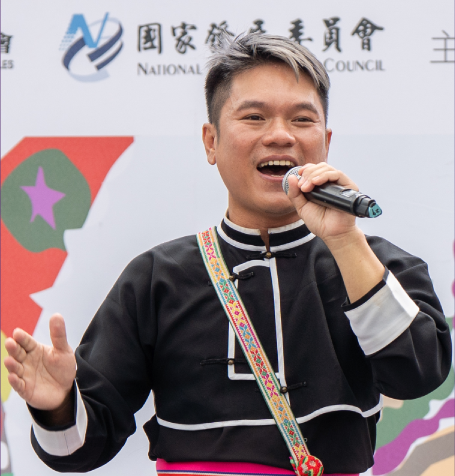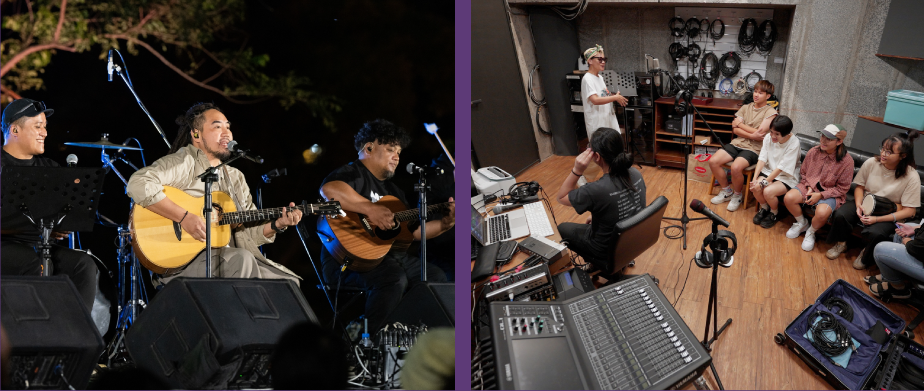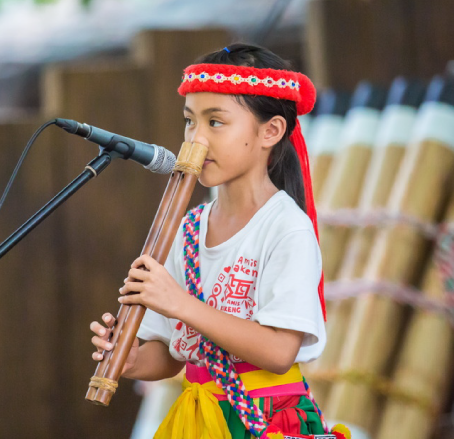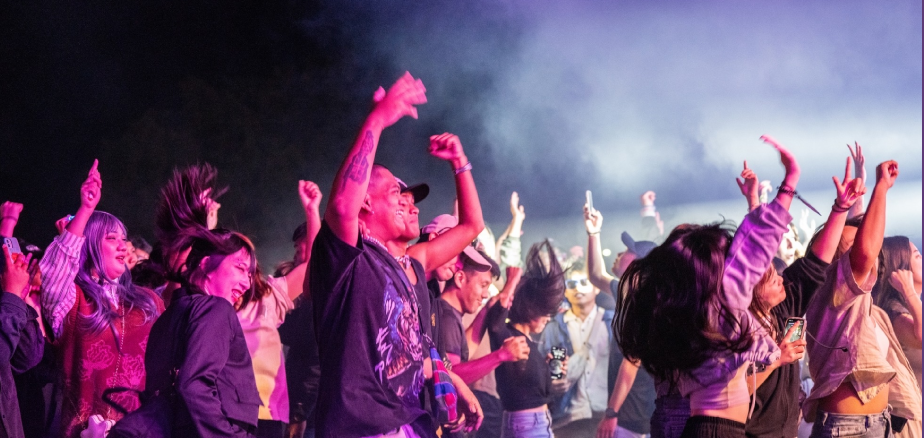 |
The Sound of Music - Unveiling Taitung’s Melodic Tapestry

Music and dance, the oldest forms of human creative expression, have deep roots in Taitung, a region rich in prehistoric heritage. Despite its intangible nature and the oral transmission of indigenous culture, the modern era marked a turning point when the first indigenous music was recorded and shared with a broader audience. For many years, due to colonialism and repression, indigenous culture in Taiwan, including its music, was neglected. However, in recent times, there has been a rediscovery of indigenous music, which has gradually made its way into the mainstream of the Taiwanese music industry. This resurgence is a multifaceted phenomenon, fueled by a rich musical tradition cultivated over millennia, unwavering support from the Taitung County Government, and the talent and dedication of both indigenous and non-indigenous artists. From Sacred Rituals to Public Appreciation
 Music and dance in Taitung historically served a sacred and ritualistic role, with entertainment being a secondary consideration. Festivals and ceremonies provided a stage for indigenous music, acting as a means of communion between humans and the spiritual realm. The immersive experience of drumming, singing, and dancing during harvest festivals exemplifies this profound connection. With the advent of the modern age and the introduction of recording technology, the perception and consumption of traditional indigenous music began to shift. Initially, Taitung's tribal music was recorded merely as a curiosity or for anthropological purposes, reaching only a limited audience. It remained isolated from the dominant Mandarin and Hokkien pop music industry centered in Taipei. Emergence of Indigenous Artists and Commercialization
 In the post-World War II era, talented indigenous artists from Taitung, such as Pinuyumayan Baliwakes Raera (1910 – 1988), began composing, recording, and performing songs in their native languages. This marked a significant milestone in the journey of Taitung's indigenous music toward the mainstream, as they started captivating non-indigenous audiences. Although these performances were initially small-scale, they signaled a shift: indigenous music could now be enjoyed outside of its traditional context, becoming a form of entertainment that also provided artists with income. The commercialization of Taitung's indigenous music gained momentum in the latter half of the twentieth century, transforming it into a cultural product. The next logical step was the fusion of indigenous melodies and lyrics with Mandarin, Hokkien, and even Hakka influences. This blending of commercial-oriented Mandarin and Hokkien pop with traditional indigenous music coincided with Taiwan's soft power peak and the awakening of a pan-Taiwanese identity at the turn of the new millennium. The final chapter in this narrative, the breakthrough of indigenous music in the Taiwanese mainstream, unfolded just over a decade ago, led by a young Amis talent from Dulan named Suming Rupi. His eponymous debut album garnered critical acclaim, winning Best Album at the 2010 Golden Indie Music Awards, Best Indigenous Language Album at the 2011 Golden Melody Awards, and ranking among the top 10 albums of the year by the Chunghwa Music Professionals Association. The Rise and Rise of a “Tribal Wave”

Suming’s success shone an intense spotlight on Taitung’s burgeoning music scene. It provided him the influence to spearhead Taiwan’s first major indigenous music festival—the Amis Music Festival, held in Dulan since 2013. Though named for the Amis, it celebrates all of Taiwan’s tribal traditions. Over time, the event expanded to feature indigenous artists worldwide, fully realizing its “from local to global” vision. This triggered a genuine “gold rush,” with Taitung musicians finally gaining recognition and commercial success long overdue. Gone were the days when “indigenous music” automatically meant traditional fare—contemporary artists now channel tribal identity through every genre imaginable. Jinfeng’s Matzka fuses reggae and Paiwan roots; chart-topping pop-rocker A-Mei draws from Pinuyumayan traditions; Paiwan/Amis rapper BCW reps Heping Dawu with fierce hip-hop flows. Behind the scenes, the Taitung County Government actively nurtured this boom through a variety of talent cultivation programs. This symbiosis of governmental support and artistic prowess has transformed Taitung into a top musical hub—attracting talents from Taiwan and abroad alike. American artist DJ Hatfield collaborates extensively with Amis performers as translator and co-creator. Acclaimed Paiwan musician Balai relocated from Pingtung, as did Amis singer Ilid Kaolo of Hualien. Buoyed by the Amis Music Festival’s success, the county has organized numerous other music events—from the Taitung Sound Art Festival to PASIWALI to the Starry Taitung Night Concert series—each celebrating the region’s singular creative spirit. PASIWALI
 Translated as "heading east" from the Amis indigenous language, PASIWALI has become a musical odyssey since its inception in 2018. Spanning thousands of kilometers across the Austronesian Indo-Pacific, it reimagines the ancestral footsteps of indigenous peoples. Pasiwali vibrantly celebrates Taitung's indigenous heritage as part of the Taitung County Government's plan to establish the region as an "Austronesian Cultural Capital." Unfolding at the lush Taitung Forest Park, the festival showcases captivating musical performances and diverse experiences that highlight tribal traditions. Attendees can immerse themselves in interactive houses, arts immersions, and indulge in traditional cuisine and handicrafts at the vibrant marketplace. Symbolic installations throughout Taitung embody the festival's spirit, while the ubiquitous wild boar mascot signifies the significance of Pasiwali. The festival welcomes talents from the Austronesian world and beyond, including Suming and musicians from Indonesia. Through the universal language of music, Pasiwali joyously celebrates Taitung's indigenous traditions, setting the rhythm for the county's vision as an Austronesian Cultural Capital where diverse heritages thrive in harmony. Attendees can embrace the festival's festive spirit and experience meaningful cultural immersion. Starry Taitung Night Concert
In 2018, the Taitung County Government introduced the "Starry Taitung Night Concert," a visionary initiative helping widen Taitung's musical landscape beyond indigenous traditional music. This concert series, held across the county, leverages the scenic and historical features of Taitung. The strategic choice of the Baxian caves, where the earliest human remains in Taiwan were discovered, as one of the concert venues holds profound significance. Each session is intricately paired with string ensemble performances. The ethereal melodies of the strings, coupled with the eternally scintillating celestial canopy above, imbue both the audience and performers with time-and-space-transcending awe. In Taitung, music goes beyond mere cultural expression and heritage; it becomes a dynamic conduit, not just for industry and livelihood but also a vessel carrying the boundless imagination of human existence. SeMaSeNaN
After tribal and classical music, the spotlight turned to Electronic Dance Music. In 2020, the ECMF Electronic Dance Music Festival, also known as SeMaSeNaN, took center stage. Set against the picturesque eastern coastline, ECMF showcases a dynamic fusion of musical talents and artistic expressions. This electronic dance music extravaganza features renowned Taiwanese DJs who skillfully blend traditional indigenous music with modern beats and textures. Colorfully adorned tribal dance troupes often join the festivities, delivering captivating performances. The festival treats attendees to live concerts spanning diverse genres, including pop, rock, and jazz, catering to a wide range of musical tastes. Beyond the concerts, ECMF offers interactive installations that seamlessly merge technology and culture. Market stalls present local gourmet cuisine and handmade crafts, providing a comprehensive cultural experience. ECMF embodies Taitung's distinctive creative spirit and natural beauty, expressed through the universal language of music, dance, and art. Regular Performances
 For travelers arriving in Taitung during the few periods without major music events, there's no need to worry! The Amis Center hosts regular performances of indigenous music throughout the week, courtesy of the local Kakeng Orchestra. Led by Sawtoy Saytay, this ensemble breathes life into traditional Amis instruments, creating a captivating symphony resonating through bamboo drums, nose flutes, and side-blown flutes. The orchestra's name, "Kakeng," symbolizes the traditional tool used to spread joyous news, reflecting their mission to share the cultural essence of the Amis people through music. Beyond their musical prowess, the orchestra engages in cultural preservation by releasing albums like "Ina's Childhood," featuring Amis-language children's songs. The Kakeng Orchestra is not merely a musical group; it serves as a guardian of tradition, nurturing cultural pride and awareness among the younger generation. They ensure that the timeless melodies of the Amis tribe continue to reverberate throughout the ages. Adieu Tiehua Music Village
 No discussion of Taitung's music scene would be complete without acknowledging the significance of Tiehua Music Village. Since its establishment in 2010, this transformed railway warehouse has played a crucial role in nurturing local talents and hosting over 3,400 concerts, marking a remarkable chapter in Taitung's musical evolution, transitioning from the fringes to the mainstream. In a heartfelt announcement, the Lovely Taiwan Foundation, in collaboration with the Taitung County Government, revealed that Tiehua Music Village will gracefully conclude its journey at the end of this year. With the mission of promoting indigenous music, Tiehua Music Village swiftly became a cornerstone of Taitung's music landscape. This "village" served as a vital stage for both emerging and renowned artists, contributing to the region's vibrant musical tapestry. The closure of Tiehua Music Village signifies the end of an era and the dawn of a new one. As mentioned earlier, the years 2010-2011 were a turning point for Taitung indigenous music, as there were limited venues for artists to perform regularly, and Tiehua Music Village provided a precious space for them. After 13 years of success and increasing exposure, Taitung now boasts numerous venues and festivals where local artists, both longstanding and newly arrived, can showcase their talent. Tiehua Music Village has fulfilled its role as an incubator for Taitung's music scene. The Taitung County Government remains dedicated to the continued prosperity of Taitung's music scene, and there is no doubt that the journey of Taitung's musical history will continue to reach new heights in the years to come. |
| © TAITUNG COUNTY GOVERNMENT 2023 |






